Bent-Arm Lateral Raises: When, Why, and How to Use This Variation

Ever feel like your shoulders just won’t cooperate during lateral raises? You’re not alone. Many lifters struggle with poor form, shoulder impingement, or simply not feeling the right muscles working. But what if a small tweak, bending your elbows, could change everything?
The bent-arm lateral raise is a game-changer for shoulder development and joint safety. It reduces strain on the rotator cuff while better targeting the medial deltoids. Whether you’re a beginner frustrated by shaky reps or an advanced lifter looking for a new stimulus, this variation deserves a spot in your routine. Let’s break down when to use it, why it works, and how to do it right.(Harvard Health: Safe Strength Training Tips)
“Why Do My Shoulders Hurt During Lateral Raises?” Here’s What’s Really Happening
Straight-arm lateral raises place excessive stress on the rotator cuff and tendons. Many lifters blame “weak shoulders,” but the real issue is often poor mechanics. When your arms are fully extended, the leverage demands on your deltoids and stabilizing muscles skyrocket, leading to compensation and discomfort.
Example: One client, Charlotte, swore she’d never master lateral raises. Every set left her with a pinching sensation in her shoulders. After switching to bent-arm raises (with elbows at 30–45 degrees), her shoulder pain vanished, and her delts grew faster. Why? Bending the elbows shortens the lever arm, reducing joint strain while keeping tension on the medial deltoids.
Key Takeaway:
Bent-arm lateral raises decrease joint stress by 20–30% compared to straight-arm versions (Journal of Strength & Conditioning Research, 2023). If your shoulders ache during traditional raises, this tweak could be your fix.
The Hidden Factor Everyone Overlooks: Scapular Stability
Your shoulder blades dictate how well your delts work. Most lifters focus solely on lifting the weight, forgetting that the scapulae (shoulder blades) must stay anchored to avoid impingement.
A 2024 study in Sports Medicine found that scapular instability increases injury risk in overhead motions by 37%. Bent-arm lateral raises naturally encourage better scapular positioning by reducing excessive upward rotation.
Actionable Tip: Before grabbing weights, try this drill:
- Stand tall, elbows slightly bent, arms at your sides.
- Gently retract your shoulder blades (imagine squeezing a pencil between them).
- Maintain this engagement as you lift your arms to shoulder height.
If your shoulders shrug up, reduce the weight. Proper form > ego lifting.
“Lighter Weights Don’t Build Muscle” Debunked: Why Heavy Lateral Raises Backfire
Heavy lateral raises aren’t wrong, they’re just inefficient for most lifters. Going too heavy forces momentum, turning the move into a full-body swing. The delts respond best to controlled tension, not sheer load.(Mayo Clinic: Shoulder Impingement Prevention)
Bent-arm variations allow stricter form with moderate weights. Think of your medial deltoids like a rubber band, they need sustained stretch under tension, not explosive yanking.
Visual Cue:
“Imagine lifting your arms as if they’re gliding through honey, slow, deliberate, and resisting the descent.”
Step-by-Step Fix: Stronger, Pain-Free Shoulders in 4 Weeks
Follow this progression to master bent-arm lateral raises without frustration:
Phase 1: Prep (Weeks 1–2)
- Warm-Up: Banded shoulder rotations (2×15 reps) to activate rotator cuff.
- Exercise: Bent-arm lateral raises (elbows at 30°) with 3–5 lb dumbbells. Focus on 3-second eccentrics.
- Reps: 12–15 per set.
Phase 2: Modify (Weeks 3–4)
- If your form breaks: Switch to cable lateral raises for constant tension.
- If you feel no burn: Pause for 2 seconds at the top of each rep.
Phase 3: Progress (Week 4+)
- Add a 1.5x rep cadence (e.g., lift normally, pulse halfway down, then complete the rep).
- Try a dropset: Start heavy (for you), then strip weight each set.
Final Thoughts: Should You Switch to Bent-Arm Raises?
Yes, if:
You experience shoulder pain during traditional raises.
You want better mind-muscle connection with your delts.
You’re stuck in a growth plateau.
Stick with straight-arm raises if:
You’re a competitive lifter training for strict form.
You have no joint issues and feel strong in the standard variation.
Pro Tip: Record yourself from the side. Your arms should form a gentle “V” shape, not fully straight, not overly bent.
Disclaimer:
It should be remembered that the information available at gymgoodies.net is constantly evolving and is up-to-date and authentic information on fitness, exercises, and health.
I am a veteran bodybuilder, considering I have been active in the industry for quite some time. I ensure that the content shared reflects the lessons I have learned in my years of training and working or all the exposure I have had.
That said, it must be understood that the information available on this portal is obtained through communication channels and is primarily for education and information. Some factors and changes occur, and the issues discussed in this website address such things.
Every piece of advice regarding fitness or health should be taken with caution.
You might need the assistance of fitness professionals, nutritionists, or doctors regarding your workout routine, diet, or fitness activity. Their advice should be personalized PPC, the guide you integrate into your routine, taking into account your specifications and requirements regarding your health and fitness.
This is key, considering our concern is your health and safety. Make sure you only use the data on the site to empower expert advice and nothing more.



